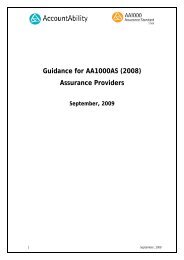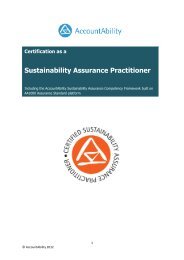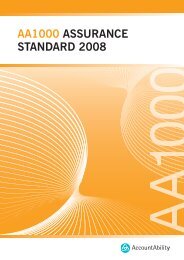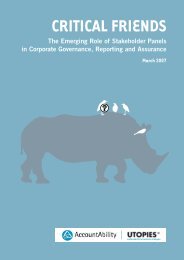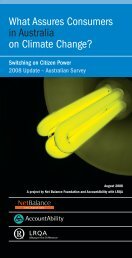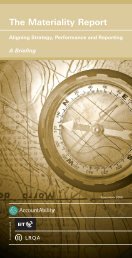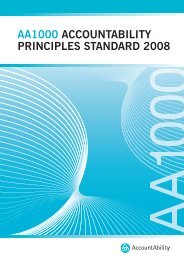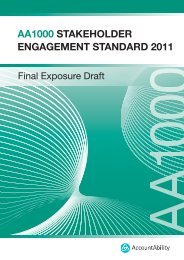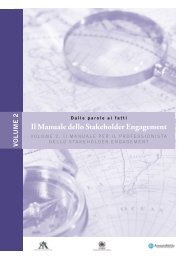The Stakeholder Engagement Manual Volume 2 - AccountAbility
The Stakeholder Engagement Manual Volume 2 - AccountAbility
The Stakeholder Engagement Manual Volume 2 - AccountAbility
You also want an ePaper? Increase the reach of your titles
YUMPU automatically turns print PDFs into web optimized ePapers that Google loves.
‘What we know’<br />
‘What they tell us’<br />
‘ What they say<br />
about us’<br />
Sources of information for stakeholder concerns and expectations<br />
STAGE 1<br />
Individuals within the organisation will already have some knowledge of stakeholder<br />
concerns from their current contacts with stakeholders and understanding of the issues<br />
affecting their part of the organisation. <strong>Stakeholder</strong>s will already be raising issues through<br />
existing feedback mechanisms from customer hotlines to investor relations meetings. This<br />
existing knowledge could be brought together through a process of systematic review,<br />
interviews or workshops with key managers and stakeholders close to the organisation.<br />
In some cases it may be best to leave the identifi cation of issues open and set the agenda<br />
with the stakeholders during the engagement process itself. However, while this does allow<br />
for maximum stakeholder involvement in identifying issues, it may lead to unmanageable<br />
dialogue which is diffi cult to feed into decision making processes, and leaves stakeholders<br />
frustrated that the engagement is all talk and no action.<br />
More passive monitoring of stakeholder viewpoints about the company and industry<br />
impacts and performance can also be used to identify issues without raising stakeholders’<br />
expectations at this Stage. This might include monitoring information sources such<br />
as national, local, and relevant specialist and academic press, government and<br />
intergovernmental organisations’ communications or reports, NGO campaigns, infl uential<br />
public and opinion research and relevant internet discussion forums.<br />
Compare your strategic engagement objectives with the issues you have<br />
highlighted through the materiality test. Each of your strategic engagement<br />
objectives is likely to relate to a number of issues. E.g. satisfying your customers<br />
demand for responsibly produced goods may require you to consider various<br />
human rights, environmental and health and safety issues. If you feel that any<br />
issue is missing, make sure you include it into your list of issues, and assess it<br />
according to the fi ve-part test, too.<br />
Using the above-mentioned sources of information, as appropriate, list<br />
the issues in the matrix (T3). Th en insert the stakeholder groups or sub-groups<br />
already identifi ed.<br />
Apply the materiality test by considering each of the issues in relation to each<br />
of the fi ve dimensions. Insert a colour-code as suggested in the matrix, and/or<br />
provide descriptive assessments of the materiality of the issue to the individual<br />
dimensions of the materiality test.<br />
Consider the degree of concern amongst stakeholders regarding the issue<br />
and again capture your results in the table, by using the scoring suggested in the<br />
table, and/or by providing descriptive assessments of the stakeholders’ concerns.<br />
Ensure a validation of the matrix. <strong>The</strong> issue/stakeholder matrix provides a<br />
record of the identifi cation and analysis of stakeholders and issues at this Stage<br />
and should be validated by relevant managers and departments, as well as any<br />
other stakeholder groups or experts you are already working with.<br />
<strong>The</strong> matrix provides a preliminary prioritisation of stakeholders, telling<br />
you which ones are most concerned about which issues. Further steps for<br />
prioritisation will follow. See also the ‘How to Use’ guide at the bottom of the<br />
methodology.<br />
THE PRACTITIONER'S HANDBOOK ON STAKEHOLDER ENGAGEMENT | 37



